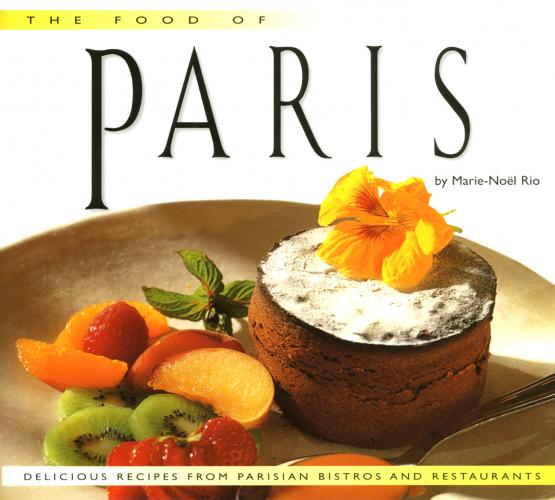Published by Periplus Editions with editorial offices at 61 Tai Seng Avenue, #02-12 Singapore 534167.
Copyright © 2002 Periplus Editions (HK) Ltd.
All rights reserved.
ISBN: 978-1-4629-0977-3 (ebook)
Library of Congress
Control Number: 2002101481
Photo credits
All food and location photography by Jean-François Hamon.
Additional photos by Luca Invernizzi Tettoni (page 2).
Endpaper: Painting by M. Spiewak Misia.
Distributed by
USA
Tuttle Publishing
364 Innovation Drive
North Clarendon,
VT 05759-9436 USA
Tel: (802) 773-8930
Fax: (802) 773-6993
Japan and Korea
Tuttle Publishing
Yaekari Building 3rd Floor, 5-4-12
Osaki Shinagawa-ku,
Tokyo 141-0032
Tel: (81-3) 5437-0171
Fax: (81-3) 5437-0755
Asia Pacific
Berkeley Books Pte. Ltd.
61 Tai Seng Avenue, #02-12
Singapore 534167
Tel: (65) 6280-1330
Fax: (65) 6280-6290
First Edition
Printed in Singapore
THE FOOD OF
PARIS
Authentic Recipes from Parisian Bistros and Restaurants
by Marie-Noël Rio
Photography by Jean-François Hamon
Styling by Sophie Jacquesson
Translation by Vincent Vichit-Vadakan
Featuring recipes from the following restaurants:
| A & M Le Bistrot Chez Casimir Chez Catherine Marty Mollard Les Olivades | Paris Main d'Or Rôtisserie du Beaujolais Saint-Antoine Le Train Bleu Le Troquet Le Zéphyr |
The Champs-Elysées is one of the most fashionable streets in Paris and is lined with numerous cafes and restaurants.
Contents
Appetizers 44
Desserts 122
Acknowledgments 142
Index 144
Part One: Food in Paris
A slice of culinary history
The identity of France—the European nation with the longest history of tenacious centralized government—and the identity of Paris, its capital, have been closely intertwined for centuries. Since the 13th century, when Philippe-Auguste built the fortifications around the city and set up his royal palace, Paris has been the stage on which French social mores have always been defined. And none more so than the tradition of food, which has played a major role in French society since the Middle Ages.
In Medieval times the subtleties of fine dining were only enjoyed by the ruling classes. The poor contented themselves day in day out with a diet of black bread and gruel. The kitchens of the Court served white bread with tender meat of poultry and game, spices, and exotic fruits, washed down with generous amounts of claret or other headier wines. Dairy products, most red meat, and vegetables were left to the commoners, along with cheap wines, cider, and beer.
In the 17th century, the heart of France was neither Paris nor Versailles, but the body of Louis XIV, the Sun King. When his power was at its zenith, the King's meals—like the rest of his private life—were lavish affairs attended by the notables of the day. Cooking took a decisive turn. La Quintinie, who benefited from being in the King's favor, made orchards and vegetable-growing fashionable; the use of spices was abandoned, and the star chefs of the day stigmatized "the old-fashioned and disgusting manner of preparing things" as being "gothic" cuisine. Food became an affair of state, in fact to such an extent that Vatel, who was responsible for the King's entertainment and his table during a visit to the Prince de Condé, chose suicide when his delivery of fish failed to materialize on time. Of course, such considerations only concerned nobility. Commoners for their part were starved as never before.
In the 18th century, the Regent took up quarters in Paris, far from the outdated etiquette of Versailles. Pleasure, once rejected by Madame de Maintenon because of her fear of eternal damnation, came back into fashion. The first restaurants appeared and caused a furor, making antiquated taverns and inns unstylish, too rugged for civilized tastes. The French Revolution brought an end to aristocratic privilege and introduced a relative democratization of manners. Alexandre Grimod de la Reynière, author of the Almanach des Gourmands,
